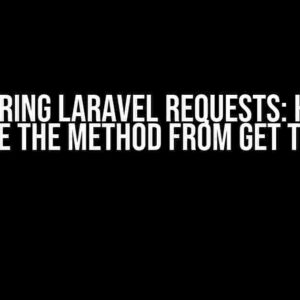Are you tired of dealing with the Nginx proxy original IP issue? Do you find yourself scratching your head, wondering why your server is being represented by the proxy’s IP instead of its own? Well, wonder no more! In this article, we’ll delve into the world of proxies, IP addresses, and Nginx configurations to help you tackle this pesky problem once and for all.
The Problem: Losing Your Server’s Identity
When you set up an Nginx proxy, it acts as an intermediary between your client and server. While this proxying mechanism provides numerous benefits, such as load balancing, caching, and security, it can also lead to an issue that might give you sleepless nights: the loss of your server’s original IP address.
This problem arises when the proxy server’s IP address is passed to your server instead of the client’s IP address. As a result, your server sees the proxy’s IP as the original IP, making it difficult to track user activity, block malicious requests, or even perform simple tasks like logging.
Why Does the Nginx Proxy Original IP Issue Occur?
The root cause of this issue lies in the way Nginx handles client requests. By default, Nginx does not pass the client’s IP address to the proxied server. Instead, it replaces the client’s IP with its own IP address, effectively masking the original IP.
This behavior is due to the way Nginx handles the X-Forwarded-For (XFF) header. The XFF header is a standard HTTP header that contains the IP address of the client. However, Nginx does not set this header by default, leading to the loss of the original IP address.
How to Resolve the Nginx Proxy Original IP Issue
Fortunately, resolving the Nginx proxy original IP issue is relatively straightforward. You can employ one of the following methods to unmask the original IP address:
Method 1: Using the proxy_set_header Directive
Add the following configuration to your Nginx proxy block:
http {
...
upstream backend {
server localhost:8080;
}
server {
listen 80;
location / {
proxy_pass http://backend;
proxy_set_header X-Forwarded-For $proxy_add_x_forwarded_for;
}
}
}
In this method, we use the proxy_set_header directive to set the X-Forwarded-For header with the original client IP address. The $proxy_add_x_forwarded_for variable appends the client’s IP address to the existing XFF header, if any.
Method 2: Using the real_ip_module
The real_ip_module is an Nginx module that allows you to rewrite the client’s IP address based on the X-Forwarded-For header. To use this method, you need to:
1. Enable the real_ip_module in your Nginx configuration:
http {
...
load_module modules/ngx_http_realip_module.so;
...
}
2. Add the following configuration to your Nginx proxy block:
http {
...
upstream backend {
server localhost:8080;
}
server {
listen 80;
location / {
proxy_pass http://backend;
set_real_ip_from 192.168.1.1; // Replace with your proxy IP
real_ip_header X-Forwarded-For;
}
}
}
In this method, we use the set_real_ip_from directive to specify the proxy IP address and the real_ip_header directive to set the XFF header.
Troubleshooting Common Issues
While the above methods should resolve the Nginx proxy original IP issue, you might encounter some common problems:
-
X-Forwarded-For Header Not Set: Make sure you have enabled the
real_ip_moduleand configured theset_real_ip_fromandreal_ip_headerdirectives correctly. -
Proxy IP Address Still Being Passed: Verify that you have added the
proxy_set_headerdirective to your Nginx proxy block. Also, ensure that the XFF header is being passed correctly by checking the HTTP headers in your proxied server’s logs. -
Multiple IP Addresses in the X-Forwarded-For Header: This can occur when there are multiple proxies involved. You can use the
$proxy_add_x_forwarded_forvariable to append the client’s IP address to the existing XFF header.
Conclusion
The Nginx proxy original IP issue can be a frustrating problem, but with the right configurations and directives, you can easily overcome it. By using the proxy_set_header directive or the real_ip_module, you can ensure that your server receives the original client IP address, maintaining its identity and allowing you to track user activity, block malicious requests, and perform other essential tasks.
Remember, a thorough understanding of Nginx proxies, IP addresses, and HTTP headers is crucial in resolving this issue. By following the methods outlined in this article, you’ll be well on your way to unmasking the original IP address and keeping your server’s identity intact.
| Directive | Description |
|---|---|
proxy_set_header |
Sets the value of a specific header in the requests sent to the proxied server. |
real_ip_header |
Sets the header to be used for determining the client’s IP address. |
set_real_ip_from |
Sets the IP addresses that are considered trusted and whose values of the specified header will be used to set the client’s IP address. |
X-Forwarded-For |
A standard HTTP header that contains the IP address of the client. |
By mastering these directives and concepts, you’ll be able to tackle the Nginx proxy original IP issue with confidence and ensure that your server’s identity remains unmasked.
Frequently Asked Question
If you’re using Nginx as a reverse proxy, you might have encountered the issue of losing the original client IP address. This can make it difficult to track user activity, block unwanted traffic, and more. Worry not, friend, for we’ve got the answers to your burning questions!
Why does Nginx proxy change the original IP address?
By default, Nginx sets the X-Forwarded-For (XFF) header with the IP address of the proxy server itself, which replaces the original client IP address. This is because Nginx acts as an intermediary between the client and the backend server, and it’s the source IP address of the request to the backend server that gets recorded.
How can I preserve the original client IP address in Nginx?
You can use the proxy_set_header directive to set the X-Forwarded-For header with the original client IP address. For example: proxy_set_header X-Forwarded-For $proxy_add_x_forwarded_for; This will append the client’s IP address to the XFF header.
What’s the difference between $remote_addr and $proxy_add_x_forwarded_for in Nginx?
$remote_addr gives you the IP address of the immediate client, which can be the proxy server itself if it’s making the request. $proxy_add_x_forwarded_for, on the other hand, appends the client’s IP address to the XFF header, which can include multiple IP addresses if there are multiple proxies in the chain.
Can I use the real_ip module to get the original client IP address?
Yes! The real_ip module can be used to get the original client IP address when behind a proxy server. You can use the set_real_ip_from directive to specify the trusted proxy IP addresses, and then use the real_ip_header directive to specify the header that contains the client’s IP address.
How can I log the original client IP address in Nginx?
You can use the log_format directive to include the original client IP address in your Nginx logs. For example: log_format main '$remote_addr - $realipremote_addr - $request_method'; This will log the client’s IP address, along with other information.








